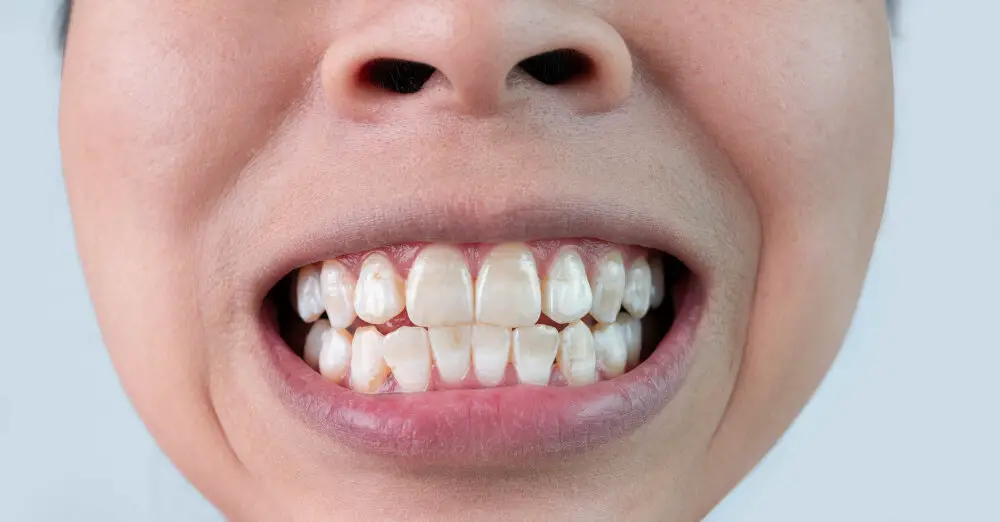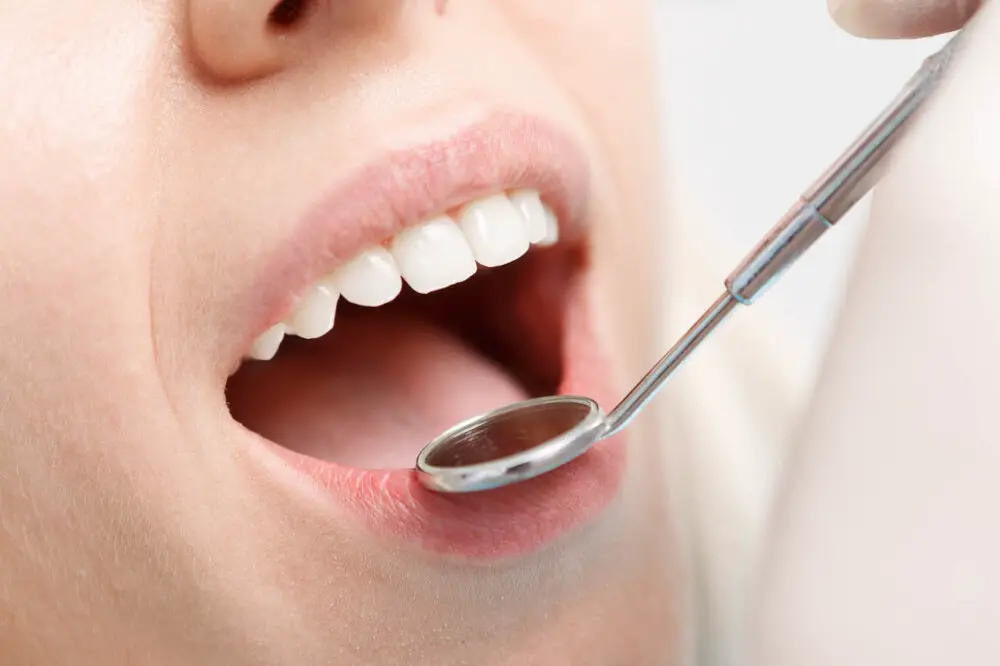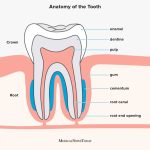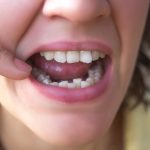Translucent Teeth: Understanding the Reasons Behind Their Appearance

Translucent teeth are a relatively common dental issue that affects millions of people worldwide. This condition is characterized by teeth that appear almost see-through, allowing light to pass through them and giving them a milky or cloudy appearance. While translucent teeth may not necessarily cause any pain or discomfort, they can be a source of embarrassment and self-consciousness for many individuals. Understanding the reasons behind the appearance of translucent teeth is therefore crucial to determining the best course of treatment and restoring a healthy, confident smile. One possible cause of translucent teeth is enamel erosion, which occurs when the protective outer layer of the teeth wears away over time. This can be due to a variety of factors, including acidic foods and drinks, certain medications, and even genetics. When the enamel becomes thin or damaged, it can cause the underlying dentin layer to show through, giving the teeth a translucent appearance. In addition to its aesthetic impact, enamel erosion can also increase the risk of tooth decay and sensitivity, making it important to address the issue as soon as possible.
Translucent teeth are a dental condition in which the teeth appear to be almost see-through or transparent, allowing the color of the dentin to show through. This condition is often the result of thinning enamel, which can be caused by a variety of factors such as aging, genetics, poor oral hygiene, or acid erosion. Translucent teeth can give the appearance of a dull, lackluster smile, and may be accompanied by sensitivity or vulnerability to tooth decay. However, with proper dental care and treatment, it is possible to improve the appearance and health of translucent teeth.
Translucent teeth have become a concern for many individuals, as they can significantly affect their smile and overall appearance. This condition occurs when the enamel of the teeth becomes thinner, allowing the underlying dentin to show through. This can cause the teeth to appear almost transparent, giving them a dull and lifeless appearance. There are several reasons why teeth may become translucent, such as genetics, aging, poor oral hygiene, and even certain medical conditions. Understanding the causes behind translucent teeth can help individuals take preventative measures to protect their teeth and improve their overall dental health.
Causes of Translucent Teeth

Translucent teeth can be a cause of concern for many individuals as they can alter the appearance of their smile. There are several reasons behind this condition, and it is essential to understand them to prevent any further damage. One of the main causes of translucent teeth is enamel erosion. Enamel is the outer layer of the tooth that protects it from decay and damage. However, when the enamel is worn away, the underlying dentin becomes visible, causing the teeth to appear translucent. This can occur due to several factors, including acid erosion from acidic foods and drinks, aggressive brushing, and tooth grinding. In severe cases, enamel erosion can lead to tooth sensitivity and even tooth loss. Another common cause of translucent teeth is genetics. Some individuals may have naturally thinner or more translucent enamel, which can be inherited from their parents. This condition can also be exacerbated by environmental factors, such as poor diet and lifestyle habits. For instance, consuming sugary or acidic foods and drinks can weaken the enamel and make the teeth more translucent over time. Similarly, smoking and excessive alcohol consumption can also cause damage to the enamel, leading to translucent teeth. Therefore, it is essential to maintain good oral hygiene practices and make healthy lifestyle choices to prevent or minimize the appearance of translucent teeth.
Enamel erosion is a gradual process of the breakdown of the outer layer of the tooth, called the enamel. This can be caused by a variety of factors, including excessive consumption of acidic foods and beverages, poor dental hygiene, and medical conditions that affect the teeth. As the enamel wears away, the underlying dentin becomes more visible, which can give the teeth a translucent appearance. This can also lead to sensitivity, as the dentin is more porous and susceptible to damage. It is important to take preventative measures to avoid enamel erosion, such as limiting acidic foods and beverages, practicing good oral hygiene, and seeking treatment for any underlying medical conditions that may be contributing to the problem.
Dentin thinness is a common cause of translucent teeth. Dentin is the layer of tooth structure that lies between the enamel and pulp. It is a hard, calcified tissue that makes up the bulk of the tooth. When dentin is thin, it can cause the tooth to appear translucent or even transparent. This can occur due to a variety of reasons, including genetics, aging, and tooth wear. In some cases, dentin thinning can be a sign of more serious dental conditions, such as enamel erosion or tooth decay. Dentists can diagnose dentin thinning through a variety of methods, including x-rays, visual inspection, and discussions with the patient about their dental history. Treatment options include dental bonding, veneers, and other cosmetic procedures.
Genetics plays an essential role in determining the characteristics of an individual, including the appearance of their teeth. The translucency of teeth is one such trait that is influenced by genetics. The genes responsible for the formation and development of teeth can affect the thickness and density of tooth enamel, which is the outermost layer of the tooth that gives it its color and translucency. Certain genetic mutations can result in thin or poorly mineralized enamel, leading to translucent teeth. Environmental factors such as diet and oral hygiene practices can exacerbate or mitigate the effects of these genetic factors. Understanding the genetic basis of translucency in teeth can help dentists and researchers develop more effective treatments and preventative measures for dental conditions related to enamel defects.
As we age, our bodies undergo various changes, and our teeth are no exception. Translucent teeth are a common occurrence among older adults, and they can be attributed to a variety of factors. One of the primary reasons for the appearance of translucent teeth is the natural thinning of the enamel over time. As the enamel wears down, the underlying dentin becomes more visible, giving the teeth a translucent appearance. Additionally, certain lifestyle factors, such as smoking and consuming acidic foods and drinks, can exacerbate the thinning of the enamel and contribute to the development of translucent teeth. It’s important to maintain good oral hygiene practices and seek the advice of a dental professional to help prevent and treat translucent teeth.
Excessive fluoride is one of the most common reasons behind the appearance of translucent teeth. Fluoride is a beneficial mineral that helps strengthen our teeth and prevent tooth decay. However, when consumed in excessive amounts, it can lead to a condition called fluorosis, which can cause opaque white spots or translucent areas on teeth. Fluorosis occurs when the enamel on the teeth becomes over-mineralized, making it appear chalky, opaque, or even translucent. This condition is more common in children who consume excessive fluoride through their drinking water, toothpaste, or other sources. While translucent teeth caused by excessive fluoride may not be harmful in most cases, it can cause dental anxiety or self-consciousness for some individuals.
Symptoms of Translucent Teeth

Translucent teeth are a condition that causes the teeth to appear almost transparent. This can occur in one or more teeth, and can be caused by a variety of factors. One of the most common causes of translucent teeth is enamel erosion. When the enamel on the teeth becomes worn down, the teeth can become more translucent. Other common causes of translucent teeth include genetics, aging, and certain medications. Symptoms of translucent teeth include teeth that appear almost see-through, as well as teeth that appear to be whiter than normal. In some cases, translucent teeth may also appear to be more delicate or brittle than normal teeth. Another symptom of translucent teeth is increased sensitivity to hot and cold temperatures. This is because the enamel on the teeth helps to insulate the teeth from temperature changes. When the enamel becomes worn down, the teeth become more sensitive to temperature changes. This can cause discomfort or pain when eating or drinking hot or cold items. In addition, people with translucent teeth may also experience an increased risk of tooth decay and cavities. This is because the enamel on the teeth helps to protect the teeth from bacteria and other harmful substances. When the enamel becomes worn down, the teeth become more vulnerable to damage.
Visible yellow or greyish coloration of teeth can be a result of various factors, including genetics, aging, tobacco use, poor dental hygiene, and certain medications. Tooth enamel, the outermost layer of the tooth, can wear away over time, causing the underlying dentin to show through, which is naturally yellow in color. Additionally, consuming foods and drinks that are high in pigment, such as coffee, tea, and red wine, can stain the teeth and contribute to their discoloration. While some people may find translucent teeth to be a cosmetic concern, it is important to note that it can also be a sign of dental erosion and decay, which can lead to more serious oral health issues if left untreated.
When it comes to oral health, many people are concerned about the appearance of their teeth. One common issue that people face is teeth that appear thin and delicate, or even translucent. This can be a cause for concern, as it may be a sign of underlying dental problems. There are several reasons why teeth may appear this way, including genetics, enamel erosion, and certain medical conditions. Understanding the reasons behind the appearance of translucent teeth can help individuals take steps to improve their oral health and prevent further damage. It is important to seek the advice of a dental professional if you are concerned about the appearance of your teeth, as they can provide guidance on the best course of action to take.
One of the most common complaints of individuals with translucent teeth is increased sensitivity to hot and cold foods and beverages. This is because translucent teeth lack the protective enamel layer that shields the underlying dentin from temperature changes. Dentin is a porous material that contains tiny tubes or channels that connect to the nerve endings in the tooth. When exposed to extreme temperatures, these nerve endings send pain signals to the brain, resulting in discomfort and sensitivity. The severity of tooth sensitivity can vary depending on the degree of translucency and the location of the affected teeth. It is important to consult with a dental professional to determine the underlying cause of tooth translucency and to receive appropriate treatment to alleviate the discomfort associated with tooth sensitivity.
Translucent teeth can be an indication of an increased risk of tooth decay. This is because the enamel, which is responsible for protecting teeth from bacteria and acid attacks, is thin and weak in translucent teeth. As a result, the tooth is more vulnerable to erosion and cavity formation. Additionally, certain habits such as frequent consumption of acidic or sugary foods and drinks, poor oral hygiene, and teeth grinding can further contribute to the risk of tooth decay. Individuals with translucent teeth should take extra care to maintain good oral hygiene and limit their intake of sugary and acidic foods to prevent further damage to their enamel and reduce their risk of tooth decay.
Treatment Options for Translucent Teeth

Translucent teeth can be a cosmetic concern for many individuals. Fortunately, there are several treatment options available to address this issue. One of the most common options is dental bonding, which involves applying a tooth-colored resin to the affected teeth. This resin helps to fill in any gaps or spaces between the teeth, creating a more uniform and aesthetically pleasing appearance. Dental bonding is a relatively quick and painless procedure that can be completed in a single visit to the dentist’s office. It is also a cost-effective option compared to other cosmetic dental treatments. Another option for treating translucent teeth is veneers. Veneers are thin, customized shells that are placed over the front of the teeth to improve their appearance. They are made from porcelain or composite resin and are designed to match the color and shape of the surrounding teeth. Veneers can be used to address a range of cosmetic issues, including tooth discoloration, chipping, and gaps between teeth. While veneers are more expensive than dental bonding, they are a long-lasting and durable option that can provide a significant improvement in the appearance of translucent teeth.
Tooth bonding and veneers are two popular cosmetic dental procedures that can help improve the appearance of translucent teeth. Tooth bonding involves the application of a tooth-colored resin to the affected area, which is then molded and shaped to match the surrounding teeth. This procedure is ideal for minor chips, cracks, and gaps, as well as for improving the color and shape of teeth. On the other hand, veneers are thin, custom-made shells that are placed over the front surface of the teeth to create a natural-looking, attractive smile. They are an excellent solution for severe cases of tooth discoloration, uneven spacing, and misshapen teeth. Both tooth bonding and veneers can provide dramatic results, giving patients the confidence to smile freely and enjoy a more youthful, vibrant appearance.
Tooth-colored fillings, also known as composite fillings, are a popular solution for repairing decayed or damaged teeth. Unlike traditional silver amalgam fillings, tooth-colored fillings are made from a blend of resin and glass particles, resulting in a natural-looking restoration that blends seamlessly with the surrounding tooth structure. In addition to their aesthetic appeal, tooth-colored fillings are also strong, durable, and resistant to wear and tear. They can be used to treat cavities, chips, cracks, and other minor dental problems, and are often preferred by patients who want to maintain a beautiful, healthy smile. With their ability to restore both form and function to damaged teeth, tooth-colored fillings are a valuable tool in modern dentistry.
Teeth whitening is a popular cosmetic dental procedure that involves the removal of stains and discoloration from the teeth. The procedure is typically performed by a dentist or dental hygienist using a bleaching agent that penetrates the enamel and breaks down the stains. While teeth whitening can be effective in improving the appearance of discolored teeth, it is not always necessary or appropriate for translucent teeth. In fact, over-whitening can actually make translucent teeth look more transparent, as it can remove some of the natural pigment that gives teeth their color. Instead, for those with translucent teeth, a dentist may recommend other cosmetic treatments such as veneers or bonding, which can help to improve the appearance of the teeth without compromising their natural translucency.
Fluoride treatments are a common dental procedure that involves the application of a fluoride gel or foam to the teeth. This treatment is used to strengthen the enamel and prevent tooth decay. Fluoride is a mineral that occurs naturally in many foods and water sources, and it has been shown to help protect teeth from decay by strengthening the tooth enamel. Fluoride treatments are often recommended for people who are at high risk for cavities, such as children, people with a history of dental problems, and those who have had recent dental work. While fluoride treatments can be effective in preventing tooth decay, they should be used in conjunction with good oral hygiene practices, such as brushing and flossing regularly, to ensure optimal dental health.
Dietary changes can play a significant role in maintaining healthy teeth and preventing translucent teeth. Consuming a diet rich in calcium, vitamin D, and phosphorus can help strengthen tooth enamel, thus reducing the risk of enamel erosion and translucent teeth. Foods high in sugar and acid, such as candy, soda, and citrus fruits, should be consumed in moderation as they can contribute to enamel erosion. Additionally, incorporating crunchy fruits and vegetables, such as apples and carrots, into one’s diet can help remove plaque buildup and promote healthy saliva production, which can also aid in preventing translucent teeth. Making simple dietary changes can go a long way in maintaining optimal dental health and preventing the unappealing appearance of translucent teeth.
Prevention of Translucent Teeth

Translucent teeth can be a cause of concern for many individuals as they may affect the appearance of their smile. However, there are steps that can be taken to prevent translucent teeth from occurring. One of the most important preventative measures is maintaining good oral hygiene. Regular brushing and flossing can help remove plaque and prevent the buildup of harmful bacteria that can contribute to the erosion of tooth enamel. Additionally, using a fluoride toothpaste can help strengthen tooth enamel and prevent it from becoming translucent. Another preventative measure is avoiding habits that can damage tooth enamel such as excessive consumption of acidic foods and drinks. Acidic substances can erode tooth enamel over time, leading to translucent teeth. Therefore, limiting the consumption of acidic foods and drinks, or rinsing the mouth with water after consuming them, can help prevent the erosion of tooth enamel. It is also important to avoid habits such as tooth grinding or using teeth as tools, which can also contribute to the erosion of tooth enamel. By taking these preventative measures, individuals can reduce their risk of developing translucent teeth and maintain a healthy, vibrant smile.
Maintaining good oral hygiene practices is crucial for healthy teeth and gums. Brushing your teeth twice a day with fluoride toothpaste, flossing daily, and using an antiseptic mouthwash can help prevent tooth decay, gum disease, and bad breath. It is also important to limit sugary and acidic foods and drinks that can erode tooth enamel. Regular dental check-ups and cleanings can detect and treat any dental problems early on. By taking care of your teeth and gums, you can not only prevent translucent teeth but also maintain a beautiful and healthy smile.
Limiting acidic and sugary foods and beverages is an essential step towards preventing translucent teeth. Consuming high amounts of acidic foods, such as citrus fruits, sodas, and vinegar, can erode the tooth enamel, leaving the teeth thin and translucent. Similarly, sugary foods and drinks can cause tooth decay, leading to weak and translucent teeth. Thus, it is crucial to limit the intake of these foods and drinks and opt for healthier alternatives, such as water, milk, and fresh fruits and vegetables. Maintaining a balanced and nutritious diet can not only prevent translucent teeth but also promote overall oral and physical health.
Using fluoride toothpaste and mouthwash is an essential step in maintaining good oral health and preventing the appearance of translucent teeth. Fluoride is a mineral that helps to strengthen tooth enamel, making it more resistant to acid erosion and decay. It also helps to remineralize areas of enamel that may have become demineralized due to acidic foods and drinks. When used regularly, fluoride toothpaste and mouthwash can help to prevent the erosion of tooth enamel and the development of translucent teeth. In addition to using fluoride products, it is also important to maintain a healthy diet and limit the consumption of acidic foods and drinks to maintain the overall health and appearance of your teeth.
Regular dental checkups and cleanings are essential to maintain good oral health and prevent dental problems such as tooth decay, gum disease, and translucent teeth. During a dental checkup, a dentist can identify any dental issues and provide appropriate treatment before they become more serious. Additionally, dental cleanings help remove plaque and tartar buildup, which can contribute to tooth decay and gum disease. By scheduling regular dental checkups and cleanings, individuals can maintain healthy teeth and gums and avoid the discomfort and expense associated with dental problems. Furthermore, these preventive measures can help individuals understand the causes of translucent teeth and take steps to prevent them.
Translucent teeth are a common dental concern that many people experience. This condition occurs when the teeth appear almost see-through, often with a bluish or greyish tint. There are several reasons why teeth may become translucent, including genetics, excessive brushing or grinding, and enamel erosion. Enamel erosion can be caused by a variety of factors, such as acidic foods and drinks, gastrointestinal reflux disease (GERD), and certain medications. While translucent teeth may not necessarily be a sign of a serious dental issue, they can still be a cause for concern, as they may be more prone to decay and sensitivity. Treatment options for translucent teeth may include dental bonding, veneers, or in severe cases, root canal therapy. It is important to talk to your dentist if you are experiencing translucent teeth to determine the underlying cause and develop an appropriate treatment plan.
Seeking professional dental care is of utmost importance for maintaining optimal oral health and preventing serious dental problems. It is particularly crucial for individuals with translucent teeth, as they are more susceptible to tooth decay and sensitivity. Professional dental care involves regular check-ups, cleanings, and treatments that can help identify and address any early signs of dental issues before they develop into bigger problems. Additionally, dental professionals have the necessary knowledge and expertise to provide personalized care and advice to patients, including guidance on proper oral hygiene and diet. By seeking professional dental care, individuals with translucent teeth can maintain the health and appearance of their teeth, as well as avoid more significant dental problems in the future.
Conclusion

In conclusion, translucent teeth can be a cause of concern for individuals who are worried about their appearance. However, it is important to understand that there are various reasons for this condition, ranging from genetics to lifestyle choices. While some translucent teeth may be a natural part of aging, others may be indicative of more serious underlying health issues. It is important to consult with a dental professional to determine the cause and appropriate treatment for translucent teeth. Maintaining good oral hygiene and making healthy lifestyle choices can also help prevent and manage this condition. Ultimately, understanding the reasons behind the appearance of translucent teeth can help individuals take the necessary steps to maintain healthy and beautiful smiles.







